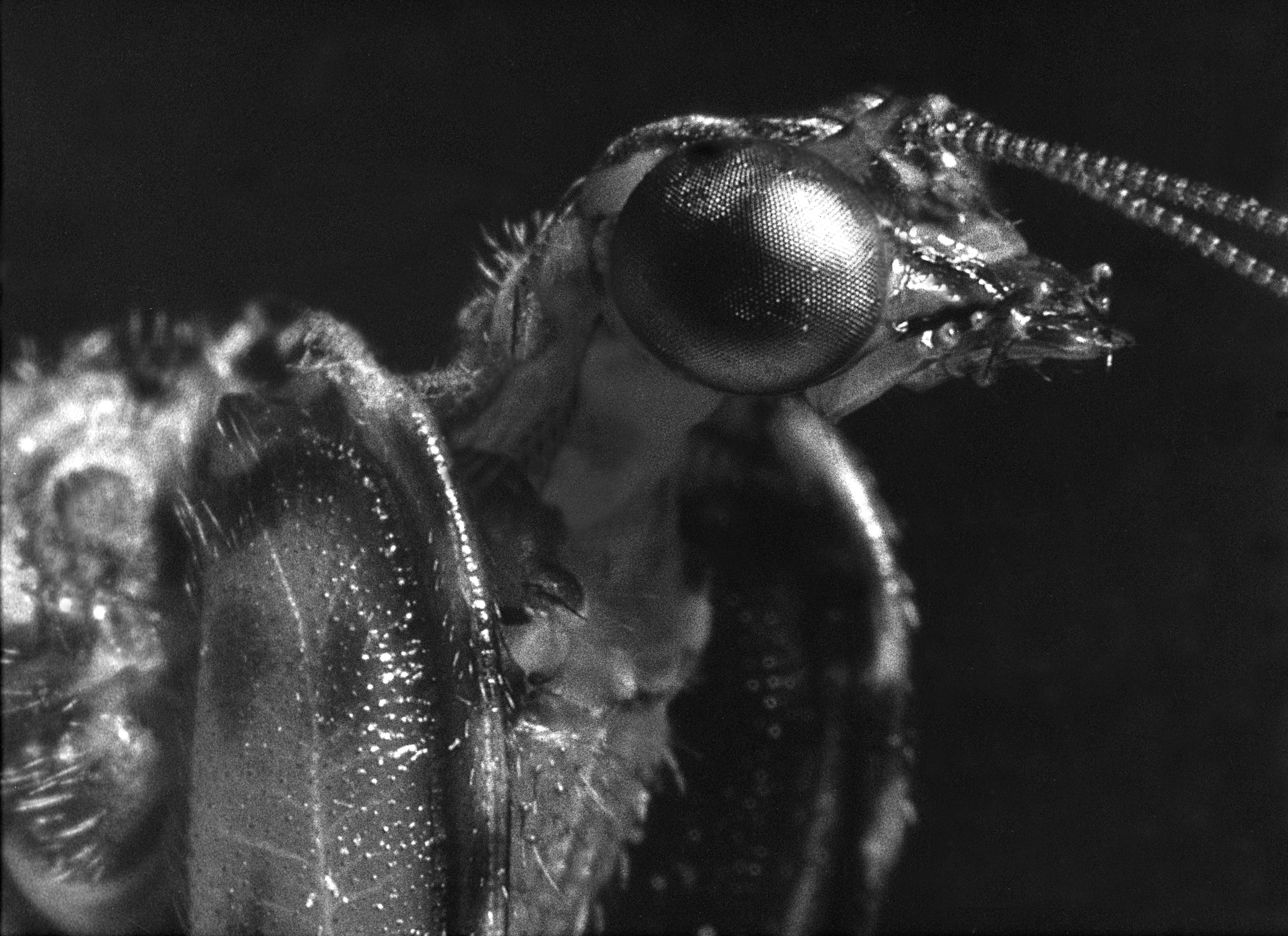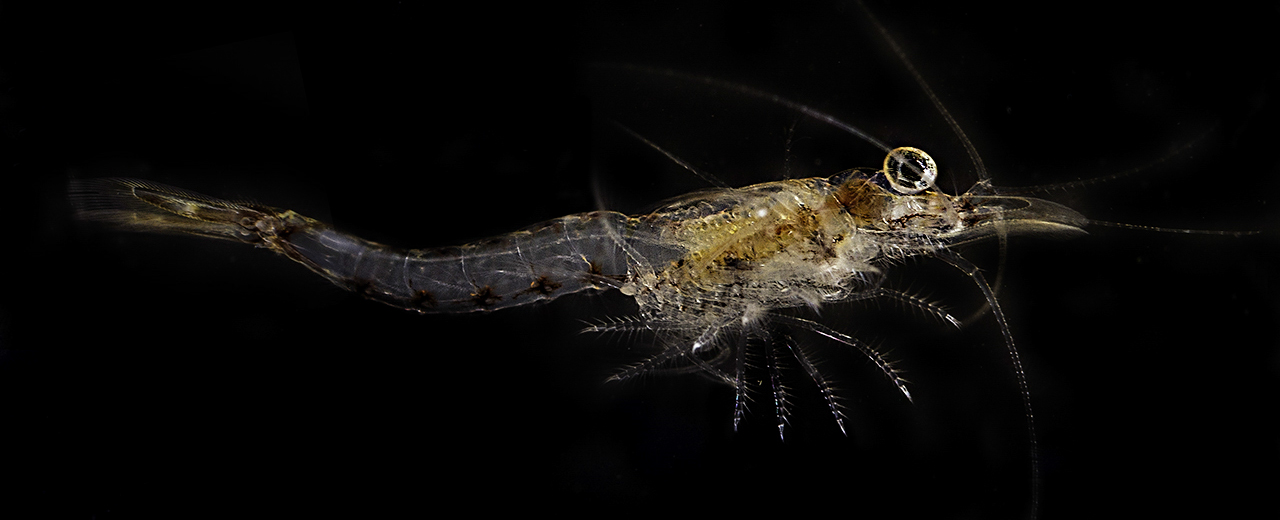|
Compound Eyes
A compound eye is a visual organ found in arthropods such as insects and crustaceans. It may consist of thousands of ommatidia, which are tiny independent photoreception units that consist of a cornea, lens, and photoreceptor cells which distinguish brightness and color. The image perceived by this arthropod eye is a combination of inputs from the numerous ommatidia, which are oriented to point in slightly different directions. Compared with single-aperture eyes, compound eyes have poor image resolution; however, they possess a very large view angle and the ability to detect fast movement and, in some cases, the polarization of light. Because a compound eye is made up of a collection of ommatidia, each with its own lens, light will enter each ommatidium instead of using a single entrance point. The individual light receptors behind each lens are then turned on and off due to a series of changes in the light intensity during movement or when an object is moving, creating a flic ... [...More Info...] [...Related Items...] OR: [Wikipedia] [Google] [Baidu] |
Sensor Array
A sensor array is a group of sensors, usually deployed in a certain geometry pattern, used for collecting and processing electromagnetic or acoustic signals. The advantage of using a sensor array over using a single sensor lies in the fact that an array adds new dimensions to the observation, helping to estimate more parameters and improve the estimation performance. For example an array of radio antenna elements used for beamforming can increase antenna gain in the direction of the signal while decreasing the gain in other directions, i.e., increasing signal-to-noise ratio (SNR) by amplifying the signal coherently. Another example of sensor array application is to estimate the direction of arrival of impinging electromagnetic waves. The related processing method is called array signal processing. A third examples includes chemical sensor arrays, which utilize multiple chemical sensors for fingerprint detection in complex mixtures or sensing environments. Application examples of ... [...More Info...] [...Related Items...] OR: [Wikipedia] [Google] [Baidu] |
Biology Letters
''Biology Letters'' is a peer-reviewed scientific journal published by the Royal Society, established in 2005. It focuses on the rapid publication of short research articles, reviews, and opinion pieces across the biological sciences. The editor-in-chief is David Beerling FRS (University of Sheffield). Contents As well as conventional short research articles, the journal has recently published ''Special Features'' and ''Mini Series''. Special Features are collections of up to 20 articles on a specific theme and published across multiple issues. Mini Series include up to six articles that are published in one issue. History The journal was split off from the '' Proceedings of the Royal Society B: Biological Sciences'' in 2005 after having been published as a supplement. Originally it was published quarterly, then bimonthly, and since 2013 it has been published monthly. Printing ceased at the start of 2020. Abstracting and indexing The journal is abstracted and indexed in: Accord ... [...More Info...] [...Related Items...] OR: [Wikipedia] [Google] [Baidu] |
Temnothorax Albipennis
''Temnothorax albipennis'', the rock ant is a species of small ant in the subfamily Myrmicinae. It occurs in Europe and builds simple nests in rock crevices. Description This species has the typical ant body pattern of head, mesosoma and metasoma, with the first two segments of the metasoma forming a distinct waist. It is light brown and has a few short pale coloured hairs. The antennae are elbowed and there are a pair of compound eyes and three ocelli. Biology 180px, left, View of head from above As with other ants, there is a single, relatively large queen that lays eggs in the nest and a large number of workers. These are all non-breeding females and leave the nest to forage and collect building materials for its construction and repair. ''T. albipennis'' builds simple nests in cracks in rocks, enclosed by walls built from tiny pebbles and grains of sand. In an experiment where two sizes of sand grain were offered to ants that were foraging for building materials, the an ... [...More Info...] [...Related Items...] OR: [Wikipedia] [Google] [Baidu] |
Ocelli
A simple eye or ocellus (sometimes called a pigment pit) is a form of eye or an optical arrangement which has a single lens without the sort of elaborate retina that occurs in most vertebrates. These eyes are called "simple" to distinguish them from " compound eyes", which have multiple lenses. They are not necessarily simple in the sense of being uncomplicated or basic. The structure of an animal's eye is determined by the environment in which it lives, and the behavioural tasks it must fulfill to survive. Arthropods differ widely in the habitats in which they live, as well as their visual requirements for finding food or conspecifics, and avoiding predators. Consequently, an enormous variety of eye types are found in arthropods to overcome visual problems or limitations. Use of the term ''simple eye'' is flexible, and must be interpreted in proper context; for example, the eyes of most large animals are '' camera eyes'' and are sometimes considered "simple" because a sing ... [...More Info...] [...Related Items...] OR: [Wikipedia] [Google] [Baidu] |
Scutigera
''Scutigera'' is a centipede genus in the scutigeromorph (house centipede) family Scutigeridae, a group of centipedes with long limbs and true compound eyes (which were once thought to be secondary, re-evolved "pseudofacetted eyes"). It is composed of more than 30 species, including the most common and well-studied species, '' Scutigera coleoptrata.'' Species Extant species * '' Scutigera aethiopica'' * '' Scutigera argentina'' * '' Scutigera asiatica'' * '' Scutigera buda'' * '' Scutigera carrizala'' * '' Scutigera chichivaca'' * '' Scutigera coleoptrata'' * '' Scutigera complanata'' * '' Scutigera dubia'' * '' Scutigera fissiloba'' * '' Scutigera flavistoma'' * '' Scutigera hispida'' * '' Scutigera linceci'' * '' Scutigera longitarsis'' * '' Scutigera marmorea'' * '' Scutigera melanostoma'' * '' Scutigera nossibei'' * '' Scutigera oweni'' * '' Scutigera oxypyga'' * '' Scutigera parcespinosa'' * '' Scutigera planiceps'' * '' Scutigera poicila'' * '' Scutigera rubrilineat ... [...More Info...] [...Related Items...] OR: [Wikipedia] [Google] [Baidu] |
Mysid
Mysida is an order of small, shrimp-like crustaceans in the malacostracan superorder Peracarida. Their common name opossum shrimps stems from the presence of a brood pouch or "marsupium" in females. The fact that the larvae are reared in this pouch and are not free-swimming characterises the order. The mysid's head bears a pair of stalked eyes and two pairs of antennae. The thorax consists of eight segments each bearing branching limbs, the whole concealed beneath a protective carapace and the abdomen has six segments and usually further small limbs. Mysids are found throughout the world in both shallow and deep marine waters where they can be benthic or pelagic, but they are also important in some fresh water and brackish ecosystems. Many benthic species make daily vertical migrations into higher parts of the water column. Mysids are filter feeders, omnivores that feed on algae, detritus and zooplankton. Some mysids are cultured in laboratories for experimental purpos ... [...More Info...] [...Related Items...] OR: [Wikipedia] [Google] [Baidu] |
Dragonfly
A dragonfly is a flying insect belonging to the infraorder Anisoptera below the order Odonata. About 3,000 extant species of dragonflies are known. Most are tropical, with fewer species in temperate regions. Loss of wetland habitat threatens dragonfly populations around the world. Adult dragonflies are characterised by a pair of large, multifaceted, compound eyes, two pairs of strong, transparent wings, sometimes with coloured patches, and an elongated body. Many dragonflies have brilliant iridescent or metallic colours produced by structural coloration, making them conspicuous in flight. An adult dragonfly's compound eyes have nearly 24,000 ommatidia each. Dragonflies can be mistaken for the closely related damselflies, which make up the other odonatan infraorder ( Zygoptera) and are similar in body plan, though usually lighter in build; however, the wings of most dragonflies are held flat and away from the body, while damselflies hold their wings folded at rest, al ... [...More Info...] [...Related Items...] OR: [Wikipedia] [Google] [Baidu] |
Praying Mantis
Mantises are an order (Mantodea) of insects that contains over 2,400 species in about 460 genera in 33 families. The largest family is the Mantidae ("mantids"). Mantises are distributed worldwide in temperate and tropical habitats. They have triangular heads with bulging eyes supported on flexible necks. Their elongated bodies may or may not have wings, but all mantodeans have forelegs that are greatly enlarged and adapted for catching and gripping prey; their upright posture, while remaining stationary with forearms folded, resembling a praying posture, has led to the common name praying mantis. The closest relatives of mantises are termites and cockroaches (Blattodea), which are all within the superorder Dictyoptera. Mantises are sometimes confused with stick insects ( Phasmatodea), other elongated insects such as grasshoppers ( Orthoptera), or other more distantly related insects with raptorial forelegs such as mantisflies ( Mantispidae) ... [...More Info...] [...Related Items...] OR: [Wikipedia] [Google] [Baidu] |
DragonFly Macrogiants E
A dragonfly is a flying insect belonging to the infraorder Anisoptera below the Order (biology), order Odonata. About 3,000 extant species of dragonflies are known. Most are Tropics, tropical, with fewer species in temperate regions. Loss of wetland habitat threatens dragonfly populations around the world. Adult dragonflies are characterised by a pair of large, multifaceted, compound eyes, two pairs of strong, transparent insect wing, wings, sometimes with coloured patches, and an elongated body. Many dragonflies have brilliant iridescent or metallic colours produced by structural coloration, making them conspicuous in flight. An adult dragonfly's Arthropod eye, compound eyes have nearly 24,000 ommatidia each. Dragonflies can be mistaken for the closely related damselflies, which make up the other odonatan infraorder (Zygoptera) and are similar in body plan, though usually lighter in build; however, the wings of most dragonflies are held flat and away from the body, while damse ... [...More Info...] [...Related Items...] OR: [Wikipedia] [Google] [Baidu] |
Corner Mirror
A corner reflector is a retroreflector consisting of three mutually perpendicular, intersection (Euclidean geometry), intersecting flat reflective surfaces. It reflects waves incident from any direction directly towards the source, but Translation (geometry), translated. The three intersecting surfaces often are triangles (forming a Trirectangular tetrahedron, tetrahedron) or may have square shapes. Radar corner reflectors made of metal are used to reflect radio waves from radar sets. Optical corner reflectors, called corner cubes or cube corners, made of three-sided glass Prism (optics), prisms, are used in surveying and laser rangefinder, laser ranging. Principle The incoming ray is reflected three times, once by each surface, which results in a reversal of direction. To see this, the three corresponding normal vectors of the corner's perpendicular sides can be considered to form a basis (linear algebra), basis (a rectangular coordinate system) (''x'', ''y'', ''z'') in wh ... [...More Info...] [...Related Items...] OR: [Wikipedia] [Google] [Baidu] |
Lobster
Lobsters are Malacostraca, malacostracans Decapoda, decapod crustaceans of the family (biology), family Nephropidae or its Synonym (taxonomy), synonym Homaridae. They have long bodies with muscular tails and live in crevices or burrows on the sea floor. Three of their five pairs of legs have claws, including the first pair, which are usually much larger than the others. Highly prized as seafood, lobsters are economically important and are often one of the most profitable commodities in the coastal areas they populate. Commercially important species include two species of ''Homarus'' from the northern Atlantic Ocean and Scampi (other), scampi (which look more like a shrimp, or a "mini lobster")—the Northern Hemisphere genus ''Nephrops'' and the Southern Hemisphere genus ''Metanephrops''. Distinction Although several other groups of crustaceans have the word "lobster" in their names, the unqualified term "lobster" generally refers to the clawed lobsters of the fam ... [...More Info...] [...Related Items...] OR: [Wikipedia] [Google] [Baidu] |








